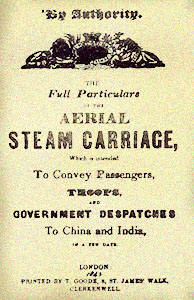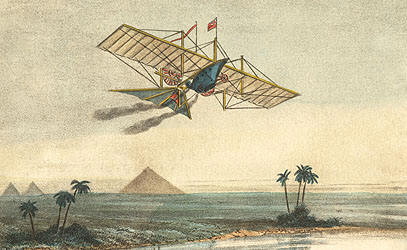Wonderful 1844 Steam-Powered Flying Machine
By
Eric Shackle
Wonderful 1844 steam
Back in 1844, almost 60 years before the Wright Brothers' historic first
flight, W.H.Phillips, of London, claimed to have invented a steam-powered aerial
machine that would carry 10 to 12 passengers 1000 miles in 10 hours.
This amazing development was described in an article published in a Sydney
newspaper with a small circulation and a long sub-title:

The newspaper was "printed and published at the Observer office, College
street (formerly called Jamison-street) by the proprietors, R. FARR & R.
KITCHEN."
There we found a remarkable but verbose story. Here it is, copied word for
word (the first paragraph contains 96):
 THE
AERODIPHROS AND AERIAL COURIER COMPANY. - A prospectus is now fairly before
the public for the formation of a company for navigating the air, the
projector of which is Mr. W.H.Phillips of Bloomsbury square, who is also the
patentee of an aerial machine, which he calls the "Aerodiphros," and
which machine he states is capable of being made to carry from ten to twelve
persons or an equivalent weight of luggage, propelled by steam power, and the
average speed to travel is 100 miles per hour, and which can be much increased
if necessary. THE
AERODIPHROS AND AERIAL COURIER COMPANY. - A prospectus is now fairly before
the public for the formation of a company for navigating the air, the
projector of which is Mr. W.H.Phillips of Bloomsbury square, who is also the
patentee of an aerial machine, which he calls the "Aerodiphros," and
which machine he states is capable of being made to carry from ten to twelve
persons or an equivalent weight of luggage, propelled by steam power, and the
average speed to travel is 100 miles per hour, and which can be much increased
if necessary.
It is stated in the prospectus that the patentee has determined the
capabilities of his machine by actual experiment; if so, he is, at all events,
in the field before Mr. Henson, and we doubt not he is prepared to enter into
such a speculation of the practicability of his scheme.
The nominal capital of the company is to be £500,000, in 5000 shares of £100
each - 2500 shares to be appropriated to the public, and the remaining 2500
shares to be the property of the inventor.
A deposit of £1 per share is to be paid at the time of application - £1
ten days after the exhibition of the first model - £3 ten days after the
first performance as of experimental trip with the second model - and £5 per
share ten days after the completion of the first grand carriage, capable of
carrying ten or twelve persons for a voyage of 1000 miles.
Persons joining the company are not obliged to continue, but can, at any
time retire, by the forfeiture of the deposit, or any instalments which may
have been paid.
We understand that the day for the public exhibition of the first model,
and its ascent, will be fixed very shortly, as the encouragement given by the
public is such as to ensure the success of the company.
--- Mining Journal.
The Sydney newspaper had copied the story from the esteemed London
publication The Mining Journal, which was founded in 1835 and is still
going strong. It also has a website, so we sent an email to its web editor,
Simon Jessop, telling him how we had discovered the article in an 1844 copy of The
Colonial Observer.
"It sounds just the sort of thing for the All Our Yesterdays slot,"
he replied. (The website displays a story from its comprehensive archives every
day).
If The Mining Journal reprints its 1844 story, then Mr. Phillips's
wonderful steam-powered flying machine will, at least metaphorically, have flown
back from Sydney to London with a speed even its inventor would never have
dreamed of.
HENSON'S EARLIER (1843) DESIGN

W.H.Phillips was not the first person to dream of harnessing steam
to power an aircraft. Two years earlier, an English engineer, William
Samuel Henson, helped by John Stringfellow, an experienced designer
and maker of light steam engines, designed ARIEL, the Henson Aerial
Steam Carriage, a passenger-carrying monoplane with a 150-feet
wingspan.
Henson's grand idea was even discussed in the House of Commons,
which, amid gales of laughter, rejected a motion to form an Aerial
Transport Company. Members scoffed at the very idea of a steam-powered
flying carriage ever taking off.
In 1843, the Aerial Transit Company's spin-doctor, Frederick
Marriott, displayed imaginative prints showing the ARIEL soaring over
the Egyptian Pyramids and flying over India, London and other places.
He also prepared the pamphlet shown at the top of this story. (Both
images reproduced by courtesy Carroll
Gray).
Sadly, Henson's dream was never realised. In 1848 the frustrated
inventor, with his wife, Sarah, emigated to the US, settling in
Newark, New Jersey.
|
Click on author's byline for bio.
|